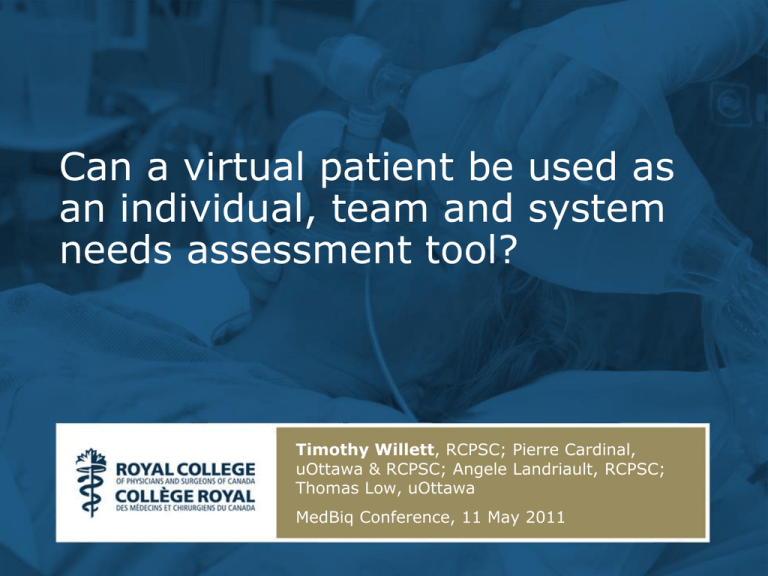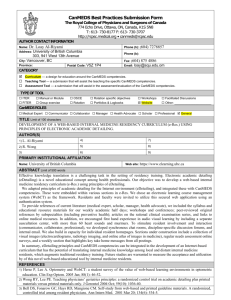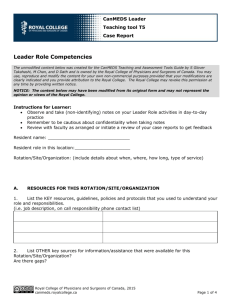PPTX
advertisement

Can a virtual patient be used as an individual, team and system needs assessment tool? Timothy Willett, RCPSC; Pierre Cardinal, uOttawa & RCPSC; Angele Landriault, RCPSC; Thomas Low, uOttawa MedBiq Conference, 11 May 2011 Disclosure • Employee of Royal College • Royal College owns SimuCase 2 Needs Assessment • 1st step in curriculum development • Perceived vs. unperceived • Not all needs are educational Moore DE, Green JS, Gallis HA. Achieving desired results and improved outcomes: integrating planning and assessment throughout learning activities. The Journal of continuing education in the health professions. 2009;29(1):1-15. Kern DE, Thomas PA, Howard DM, Bass EB. Curriculum Development for Medical Education: A Six Step Approach. Baltimore, MD: Johns Hopkins Press; 1998:192. 3 Needs assessment • Broad • ICU had self-identified desire to improve recognition & care for massive PE • Focussed • What is the ideal care? • What is reality? • What are priority needs? 4 Virtual Patients “Specific type of computer program that simulates real-life clinical scenarios; learners emulate the roles of health care providers to obtain a history, conduct a physical exam, and make diagnostic and therapeutic decisions.” Cook DA, Triola MM. Virtual patients: a critical literature review and proposed next steps. Medical education. 2009;43(4):303-11. • Variety of VPs • Linear vs. branched • Individual vs. group • Synchronous vs. asynchronous Huwendiek S, De Leng BA, Zary N, et al. Towards a typology of virtual patients. Medical Teacher. 2009;31(8):743-748. 5 SimuCase Virtual Patient • Live, face-to-face • Individual or small group • Facilitator + operator • Open-ended • Text, photos, videos, dynamic vital sign monitor • Feedback from facilitator 6 SimuCase Virtual Patient Operator Care team Facilitator 7 Research questions • Can a VP aid with needs assessment? • What kinds of needs? • Individual? • Team? • System/resource? • Perceived or unperceived? • PILOT INVESTIGATION ONLY 8 Method • Two care team groups • 1 MD (ICU fellow) • 2 RNs • 1 RT or pharmacist • Case: 65F with massive PE (based on real case) • 40 min with case, uninterrupted • Notes made by 2 MD and 1 RN facilitators • Feedback & discussion afterwards 9 The Case • Background • 65 F • 3-day hx progressive dyspnea & chest pain • PMHx hypertension • Seen in ER overnight and admitted to ICU • On exam: • Severely dyspneic • O2 sats >90% on room air • BP low by her standards • Course • Responds to O2 but dyspnea continues • Chest pain is pleuritic • BP trends down, little response to IV fluids, some response to pressors • Requires workup • Goes into PEA arrest if sent for CT or sedated or inadequate pressors • Requires thrombolysis 10 Results • Team did work as team • MD led, input from others • 1 group: RN very experienced and assertive • Discussed resources • RN: “I’ll need to leave for 2 minutes to do that – want me to?” • “Don’t have that available – need to order from pharmacy” • Knowledge, cognitive, and communication errors • Fixation on wrong diagnosis • Failure to share mental model 11 Types of Needs • Unperceived • Individual • Team • System/resource • From debrief: WHY 12 Types of Needs CanMEDS role Individual Team System/ resources Medical Expert Communicator Collaborator Health Advocate Manager Scholar Professional 13 Conclusions • Preliminary! • VP identifies unperceived needs • Individual, team and system • Variety of professional roles • Can further explore WHY • Educational for participants 14 Matrix (examples) CanMEDS role Individual Team System/ resources Medical Expert Knowledge, pt assessment, mgmt, problem-solving… Problem-solving, task prioritization… Resources for assessment & mgmt & support… Communicator Share mental model, listen, assertiveness, elicit info… Synthesis into shared care plan… Systems for comm, arranging transfer… Collaborator Own role, delegation, leadership, conflict resolution… Role adaptivity, synthesis, situational awareness, confl res… Policies on roles/ responsibilities, support for collaboration… Health Advocate Recognition & system activation… Manager Own role, leadership, priority-setting, resource allocation… Synthesize care plan, resource optimization… Scholar Insight into limitations, peer feedback… Insight into limitations… Professional Ethical practice, interprofessional attitudes… System response mechanisms, barriers to access care… Support & barriers to team-based care… 15 Next steps • More rigorous evaluation • Test as part of multifaceted needs assessment • Refine strengths, weaknesses • Does VP add anything new/different? 16 Thank you • Questions? • twillett@royalcollege.ca 17











